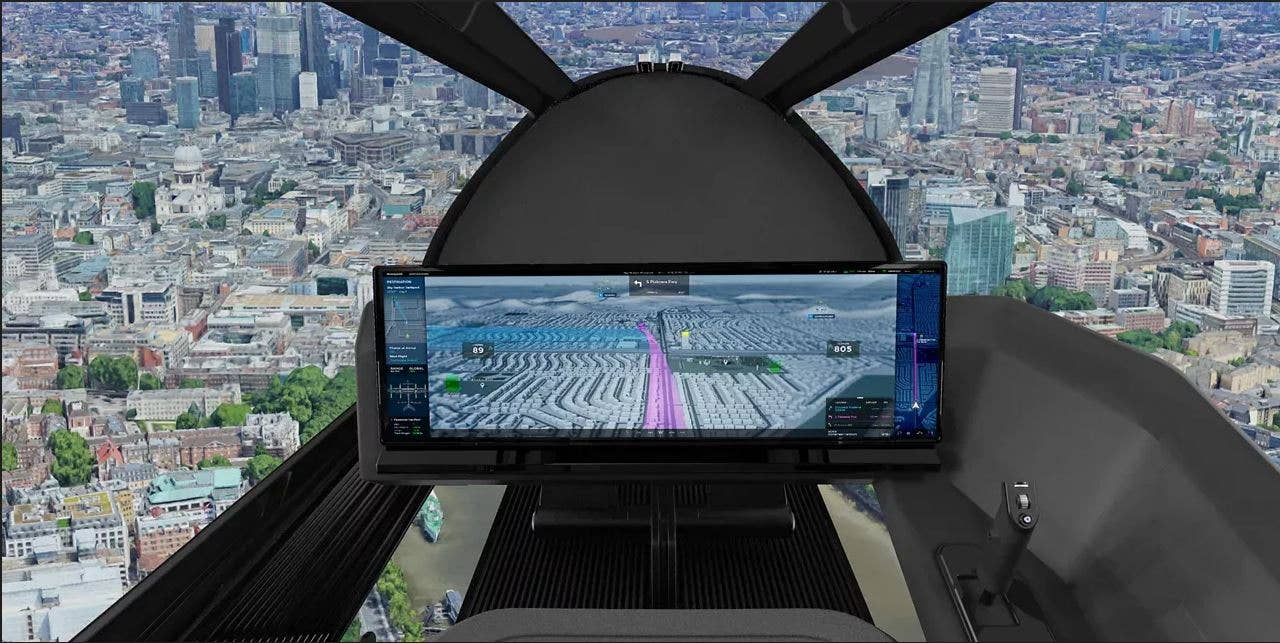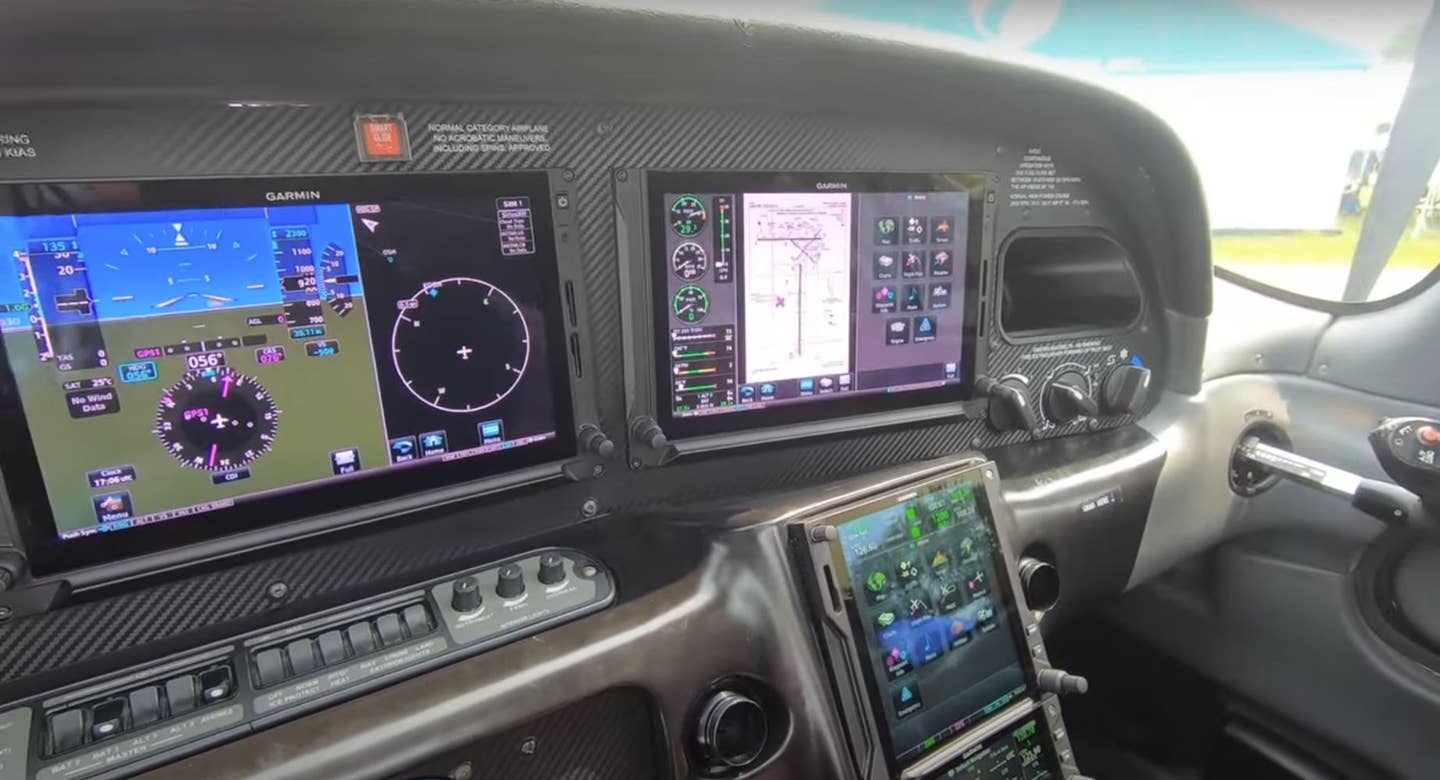
Honeywell is one of several OEMs working with eVTOL manufacturers to develop avionics systems. [Courtesy: Honeywell Aerospace]
Although the fledgling electric vertical takeoff and landing (eVTOL) industry faces a long path to aircraft certification and entering service, avionics giants are already defining the future of this new aviation sector.
No pressure. They’re just taking on the challenge of merging electronics and visual displays—across flight controls, navigation, communication, fuel systems, and threat detection—for an entirely new form of air transportation.
Things are just getting started, but it’s already clear that avionics for these new aircraft types will change how pilots receive their instrument data and how they interact with it.
Obviously, integrated display panels for eVTOLs will be a far cry from the old six-pack steam gauges of the 20th century. If all goes as planned, they’ll soon differ significantly from the glass cockpits we know today.
Let’s take a look at five ways eVTOL avionics will change how pilots fly.
1. Pilots of eVTOLs will use avionics that are easier to use.
Flying small, electric, hovering aircraft at low altitudes through a complex urban landscape will require high levels of performance by pilots as well as their avionics.
In Los Angeles alone, Joby Aviation is envisioning 300 eVTOLs performing multiple flights each day to more than 20 destinations, according to investor materials. Overall, Morgan Stanley is projecting in a best-case scenario that Joby’s entire fleet could grow to as many as 14,000 aircraft in a decade.
Industry insiders say eVTOL data sets must be consolidated. To facilitate successful pilot training, visual displays and functionality must be intuitive, smart, and simple to operate.
“They better be, because otherwise there’s just not going to be enough pilots that can fly them,” says Dan Schwinn, founder, president and CEO of Avidyne Corp. “If we think we’re going to create hundreds of thousands of super humans to fly these things, it’s just not realistic,” Schwinn tells FLYING.
Avidyne and Garmin (NYSE:GRMN) are just two of many avionics manufacturers actively working with eVTOL companies on their integrated flight decks.
Evolution of aviation flight controls:
— steven r. prediletto (@StevePrediletto) November 12, 2021
Left to Right:
1903 Wright Flyer control stick
1917 Sopwith Camel “Joy Stick”
1940s P51 center stick
1960s Bonanza M35 yoke
2000s Cirrus SR20 side stick
2020s .@volocopter autonomous eVTOL pic.twitter.com/52CuQhhPoq
Alex Bennett, Garmin’s director of aviation OEM and defense sales, says eVTOL avionics will make things simpler by alerting pilots about the most important data point at the time. It’s referred to as the “limiting factor.”
“So, it’s no longer up to the pilot to go through and think: ‘Here’s what all my temperatures, altitude, and my flying conditions are. Which gauge do I need to be paying attention to?’ Bennett tells FLYING. “The avionics are just going to say, ‘Hey, here’s the limiting factor. This is the one you have to pay attention to right now.”
2. Pilots will be using different data sets during eVTOL flights.
Key avionics data sets specific to eVTOLs will include:
• available battery power
• available range
• motor temperatures
• motor speeds
As always in aviation, weight matters. But this rule is even more important in a battery-powered aircraft, where batteries are pushed to their limits. As a result, weight will be extremely critical for eVTOL avionics.
Overall aircraft weight will remain constant—obviously because it’s not burning fuel during flight. So, a pilot’s decision whether to perform a go-around at a destination airport will be based on available battery power, making this metric one of the most important in the entire avionics suite.
First iterations of eVTOLs will likely include flight decks that look familiar to many pilots. This is because some eVTOL manufacturers are already using modified off-the-shelf integrated flight decks that are proven and FAA-certificated. It’s a strategy aimed at achieving aggressive certification schedules.
“They can’t really wait for a whole new system to be developed,” Bennett says. “They have a lot of pressure to be first to market, expand their market share, and manage investor expectations.”
California-based Joby Aviation (NYSE:JOBY), which has been flying full-sized prototypes of its tilt-rotor eVTOL since 2017, announced in February it will use Garmin’s G3000 as its initial avionics suite.
“We have a very flexible system architecture that allows us to modify through configurations without actually touching the software itself,” Bennett says. Joby says it expects its air taxi to enter service in 2024.
Future iterations of eVTOL avionics will be customized depending on the aircraft’s mission. The avionics suite of an air taxi with a mission to fly passengers on established, 25-mile routes will differ from a cargo eVTOL with a mission to deliver packages to various locations.
3. eVTOL pilots will have help from sensors scanning all directions, all the time.
There’s a good reason why manufacturers of eVTOLs have been recruiting engineers who specialize in radar, infrared, and other types of sophisticated sensor technology. These kinds of systems will be part of the aircraft and the avionics will be showing pilots what they need to know, when they need to know it.
Schwinn expects eVTOLs to include arrays of cameras positioned all around the aircraft, constantly monitoring its surroundings and feeding data to the avionics system.
What the avionics system does with that data is where this gets even more interesting.
4. Eventually eVTOL pilots will have a co-pilot named AI.
If eVTOL succeeds and regulators allow these new aircraft to fly in the national airspace, avionics engineers have big plans for the future: artificial intelligence, or AI.
“We’re trying to certify an AI to make it appropriate for a traffic detection system,” Schwinn says. “But the question is: how do you put an AI in there to interpret all this data and get some certification credit for it? That is the part of the puzzle that we’re working on with Daedalean.”
Daedalean AG, a Switzerland-based company that develops autonomous piloting software, has partnered with Avidyne to develop an intelligent, camera-based system for visual positioning, landing guidance, traffic detection, and hazard avoidance. Schwinn envisions a system that interprets data inputs from ADS-B, radar, IR, or even LIDAR (light detection and ranging) which involves laser tech.
How would avionics use sensor inputs in a panel display? “At some point, you may get a traffic alert,” Schwinn says. “On your avionics, you’ll see the traditional symbology, but you also see a picture of the traffic.”
Ideally, an AI system would be able to ID traffic both above or below the horizon, which is more difficult.
Obviously, AI-assisted avionics would need to highlight potential conflict early enough for the pilot to make an avoidance maneuver. Or, in an even more futuristic scenario, the AI would actually offer resolution advisory—a suggested, specific avoidance maneuver.
Some of this technology is already in place in other aircraft. Resolution advisory is already available in TCAS II avoidance systems. Auto TCAS, which is directly linked to the flight control system, exists on several Airbus airliner types, including the A350.
Ultimately, engineers want to develop AI-based predictive avoidance technology that will allow eVTOLs to fly autonomously, without pilots.
The success of Garmin’s Autoland emergency avionics system has not been lost on eVTOL manufacturers. In May, Joby Aviation hired engineer Didier Papadopoulos, who was instrumental in developing the award-winning system. Autoland avionics take control of an airplane if the pilot becomes incapacitated, automatically avoiding known hazards and landing at the optimum airport.
A similar product, Garmin’s Smart Glide, automates avionics for engine failure and other power emergencies.
“I think [failure and emergency] automation is very much in the short term,” says Bennett. “In the long term, all that automation is just a matter of getting the aircraft to react automatically—instead of the pilot—to do that interaction.”
Avionics OEMs and eVTOL manufacturers are still defining each other’s swim lanes in terms of who is in charge of developing which systems.
“Autopilot algorithms are developed by the avionics manufacturer,” Bennett says. “In the rotorcraft and helicopter space—especially in IFR—this has been classically owned and controlled by the OEM or aircraft manufacturer. When you talk about this new [eVTOL] space, with every function, each one of these companies is kind of redefining” which parts of the avionics they want to own and develop.
5. eVTOL pilots will be connected with the ground at all times.
With so much data in play, avionics for these new aircraft will have to be connected to more than just an air traffic control center. Depending on the eVTOL’s mission, they’ll be using 5G cellular networks or satellite comms or other systems to link with the internet and data clouds.
“These eVTOLs, they’re virtually all going to be connected virtually all the time,” Schwinn says. “We certainly are hearing about this from our customers. That’s another big, big topic for eVTOLs and their flight decks.”
Connectivity will be crucial for accessing the right data quickly. In fact, eVTOL manufacturers Lilium (NASDAQ:LILM) in Germany and Vertical Aerospace (NYSE:EVTL) in the U.K. have chosen to launch their aircraft with Honeywell’s new Anthem flight deck, which specializes in cloud connectivity. Touted as “the world’s first always-on, cloud-connected avionics,” Anthem generates and transfers data from ground-based servers so the aircraft becomes accessible through a cloud computing infrastructure.
Experts say 5G may work for low-flying air taxis and delivery eVTOLs, but it’s too soon to know for sure.
”Whatever the mission, at the end of the day, I think you’re going to see these aircraft being way more connected than we’ve seen to date on GA airplanes,” Schwinn says.
As you might expect, plenty of big questions remain, such as standardization. Will the avionics industry come together on how pilots would operate eVTOL decks? Or will pilots have to be type rated to operate avionics made by different OEMs?
Keep in mind: eVTOL aircraft have yet to be type certificated by the FAA and much needs to be done before the fledgling industry proves itself.
“Right now, it’s early days,” Schwinn says. After eVTOL moves beyond off-the-shelf avionics, things will start to pop. “When they really hit the market and mature, you’re going to see some really tightly integrated stuff. Eventually, eVTOLs are going to be the most highly integrated aircraft out there.”

Subscribe to Our Newsletter
Get the latest FLYING stories delivered directly to your inbox






